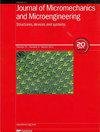二维培养乳腺癌的抗-miR19a-3p 多聚酶和多柔比星组合,以及微孔装置中三维球体的细胞凋亡检测
IF 2.1
4区 工程技术
Q2 ENGINEERING, ELECTRICAL & ELECTRONIC
引用次数: 0
摘要
乳腺癌(BC)是世界上最常见的癌症之一,也是导致女性死亡的主要原因之一。为了减少化疗药物的剂量、防止耐药性的产生并改善治疗效果,人们正在广泛研究联合疗法。在这里,我们测试了 PEI-PBA-SAP-F15 (PPSF) 聚合物纳米粒子如何有效地将微RNA拮抗剂(抗-miR19a-3p)递送至乳腺癌细胞系。我们在二维和三维细胞培养中评估了抗-miR19a-3p与多柔比星(DOX)的组合。我们在使用三维打印系统制造的创新型微流体装置中培养了三维肿瘤球体。PPSF 多聚物具有正确的尺寸和 zeta 电位,能将抗-miR19a-3p 有效地转移到 MCF7 细胞中。microRNA-19a-3p的达标基因磷酸酶和天丝同源蛋白(PTEN)的表达水平得到了提高。PTEN 的上调抑制了细胞迁移并导致细胞周期停滞。联合治疗还能明显诱导细胞凋亡。共聚焦显微镜研究发现,在转染了抗miR19a-3p-PPSF和DOX的MCF7球形细胞中,死亡细胞的数量明显增加。本文章由计算机程序翻译,如有差异,请以英文原文为准。
Combination of anti-miR19a-3p polyplex plus doxorubicin for breast cancer in 2D culture and apoptosis assay in 3D spheroids in a microwell device
One of the most common cancers and a main cause of death worldwide among women is breast cancer (BC). Combination therapy is being widely investigated to reduce the dose of chemotherapy drugs, prevent the development of drug resistance, and improve treatment outcomes. Here we tested PEI-PBA-SAP-F15 (PPSF) polymeric nanoparticles to efficiently deliver a microRNA antagonist (anti-miR19a-3p) to BC cell lines. We evaluated the combination of anti-miR19a-3p plus doxorubicin (DOX) in both 2D and 3D cell cultures. We cultured 3D tumor spheroids in an innovative microfluidic device that was fabricated using a 3D printing system. The PPSF polyplexes had the correct size and zeta potential to efficiently transfer anti-miR19a-3p into MCF7 cells. The expression level of phosphatase and tensin homolog (PTEN), the attainment gene of microRNA-19a-3p was increased. PTEN up-regulation inhibited cell migration and caused cell cycle arrest. Apoptosis was also significantly induced with the combination treatment. Confocal microscopy studies revealed that the population of dead cells was in an important degree higher in MCF7 spheroids transfected with anti-miR19a-3p-PPSF plus DOX.
求助全文
通过发布文献求助,成功后即可免费获取论文全文。
去求助
来源期刊

Journal of Micromechanics and Microengineering
工程技术-材料科学:综合
CiteScore
4.50
自引率
4.30%
发文量
136
审稿时长
2.8 months
期刊介绍:
Journal of Micromechanics and Microengineering (JMM) primarily covers experimental work, however relevant modelling papers are considered where supported by experimental data.
The journal is focussed on all aspects of:
-nano- and micro- mechanical systems
-nano- and micro- electomechanical systems
-nano- and micro- electrical and mechatronic systems
-nano- and micro- engineering
-nano- and micro- scale science
Please note that we do not publish materials papers with no obvious application or link to nano- or micro-engineering.
Below are some examples of the topics that are included within the scope of the journal:
-MEMS and NEMS:
Including sensors, optical MEMS/NEMS, RF MEMS/NEMS, etc.
-Fabrication techniques and manufacturing:
Including micromachining, etching, lithography, deposition, patterning, self-assembly, 3d printing, inkjet printing.
-Packaging and Integration technologies.
-Materials, testing, and reliability.
-Micro- and nano-fluidics:
Including optofluidics, acoustofluidics, droplets, microreactors, organ-on-a-chip.
-Lab-on-a-chip and micro- and nano-total analysis systems.
-Biomedical systems and devices:
Including bio MEMS, biosensors, assays, organ-on-a-chip, drug delivery, cells, biointerfaces.
-Energy and power:
Including power MEMS/NEMS, energy harvesters, actuators, microbatteries.
-Electronics:
Including flexible electronics, wearable electronics, interface electronics.
-Optical systems.
-Robotics.
 求助内容:
求助内容: 应助结果提醒方式:
应助结果提醒方式:


